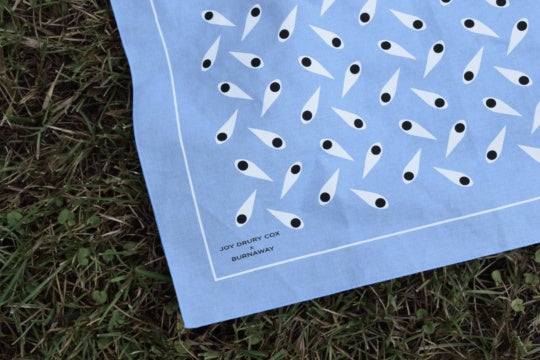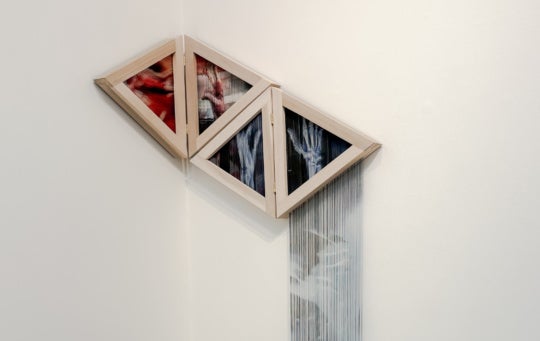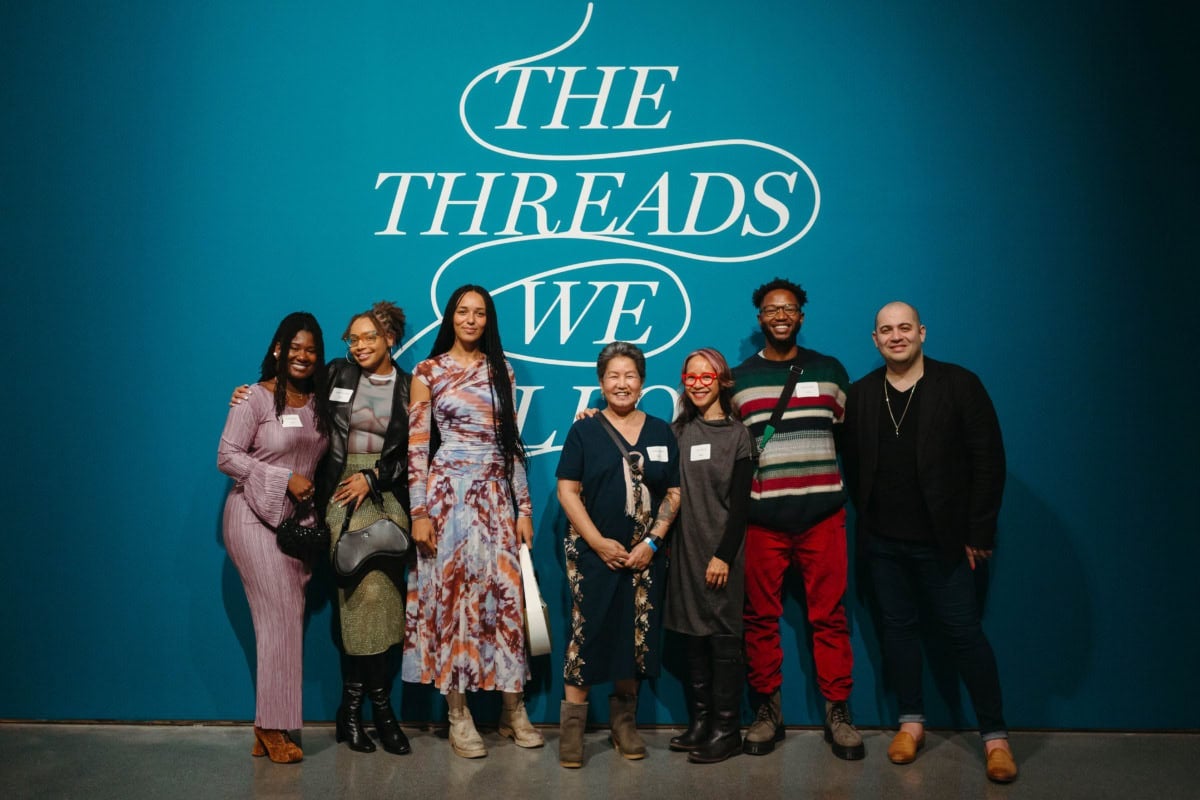
Walking into The Threads We Follow at the Southeastern Center for Contemporary Art, it felt like I had stumbled upon a choral practice at a cathedral. The show’s works, distinctly impressive on their own, form an ensemble, creating a triumphant symphony that stops even the most secular of us in our tracks. Surrounded by monumental works, I was in awe—thousands of stitches, yards of yarn, and pounds of fabric went into each piece. This rich, cohesive show brought together regional, national, and international artists, many of them crafting works specifically for the occasion.
For curator Maya Brooks, immersive exhibitions that metaphorically—and sometimes physically—envelope the audience seem like a prerequisite. Threads comes between two other prodigious shows she has organized for the museum––from the recently closed If These Walls Could Talk, covering the galleries with sprawling, site-specific murals, to the soon-to-open From Alpha to Creation, exploring religion in the deep South through a variety of mediums and sensory experiences. I was eager to talk with Brooks about her inspiration, process, and curatorial vision. We also touched on what it’s like to stage a show about textiles in the former home of industrialist James G. Hanes. (“Welcome to Winston,” a friend said as I settled into my new apartment, “the town built on tobacco, socks, and underwear.”) The following conversation was edited for length and publication.
Robert Alan Grand: In a moving speech at the show’s opening reception, you said you envisioned organizing a show like The Threads We Follow since you were 14 years old. Tell me more about your early fascination with fiber art and how the show’s concept continued to resonate.
Maya Brooks: Being an Atlanta native, I was gratefully surrounded by art and culture my entire life. I grew up taking field trips and having guided tours of institutions like the High Museum of Art at an early age. Outside of school, my parents supplemented my studies by buying biographical books about famous artists and writers so that I could better understand their lives and how they developed their ideologies. They also brought me to different art fairs and places like Underground Atlanta with them, which exposed me to local artists and the business of art.
My love for fiber arts specifically started with Georgia native Annie Greene, who used yarn to create pictorial scenes of African American life in the South. I was always captivated by her treatment of the material, her patterns, and her linework. Fast forward to today, and my love for this practice has grown as I have studied the nuances of materiality and what it means for artists to use certain objects to translate their experiences.
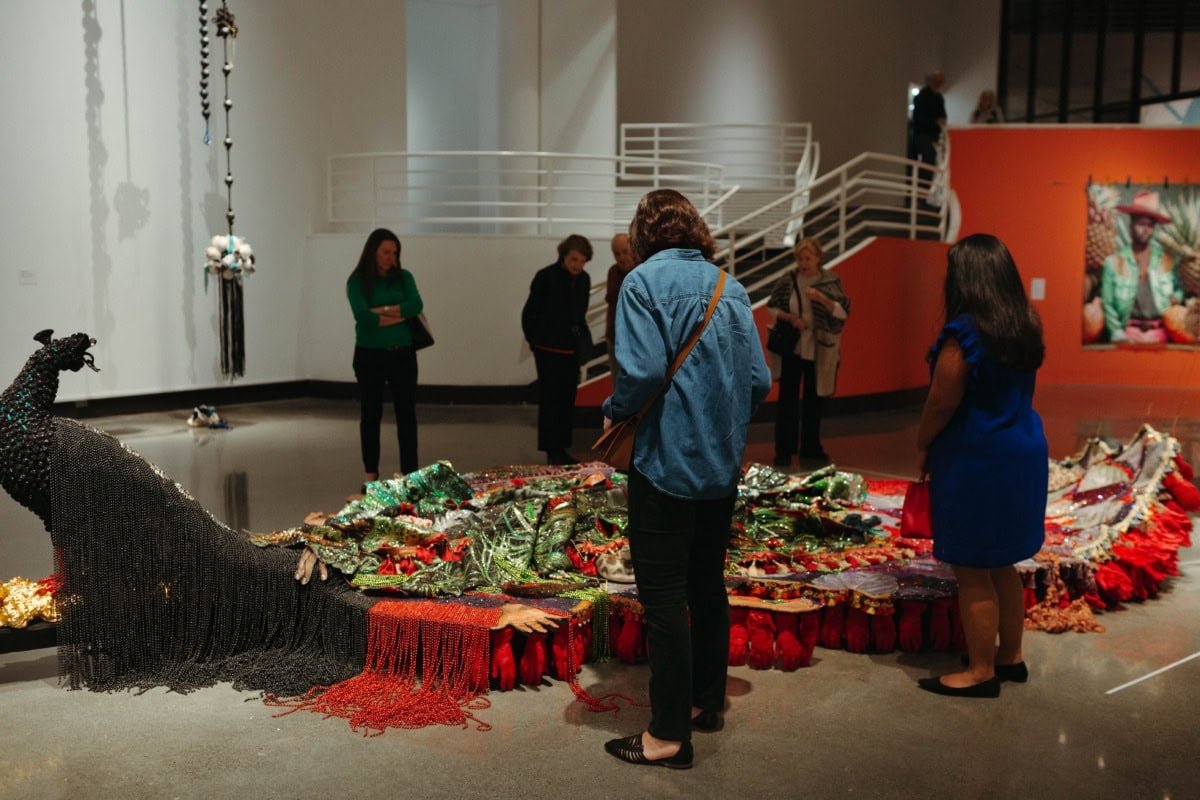
Ms. Greene’s pieces were included in a “Folk Art” section at the museum when we visited. Even back then, something about that categorization felt off to me because it mostly comprised women and Black artists who the museum said lacked “formal” training, Since then, numerous museums, including the High Museum of Art, have redefined their folk art sections. However, that memory stuck with me and influenced my consideration of traditional categories that exclude certain people.
RG: Many of the works in the show are bright, vibrant, celebratory, and shimmering. Was that a driving aesthetic for you?
MB: People would be surprised, but a lot of the process of bringing this show together was serendipitous. The only piece I had in mind for sure when I first conceptualized the show was Ebony G Patterson’s …when the cry takes root…, which I saw at the 2022 Armory Art Fair in New York. That piece stood out to me because of its placement at the fair – it was situated near one of the entrances, and I almost ran into it. I remember taking multiple videos and pictures of it because I was like, “I have to show this somehow.”
From there, the exhibition filled in as I spoke to artists that I had been interested in working with or found out about during my research phase at the beginning of 2023. I met with each artist while drafting the exhibition checklist, and we decided individually what they would contribute.
Since a lot of the pieces were new and I hadn’t seen a lot of the work before it shipped to Winston-Salem, I actually didn’t know what everything looked like in person until we laid the show out in the gallery. I was more concerned with the narratives I wanted to present up until that point. So it wasn’t until I saw everything together that I noticed the patterns of textures and colors and how they fit together, almost like a large puzzle.
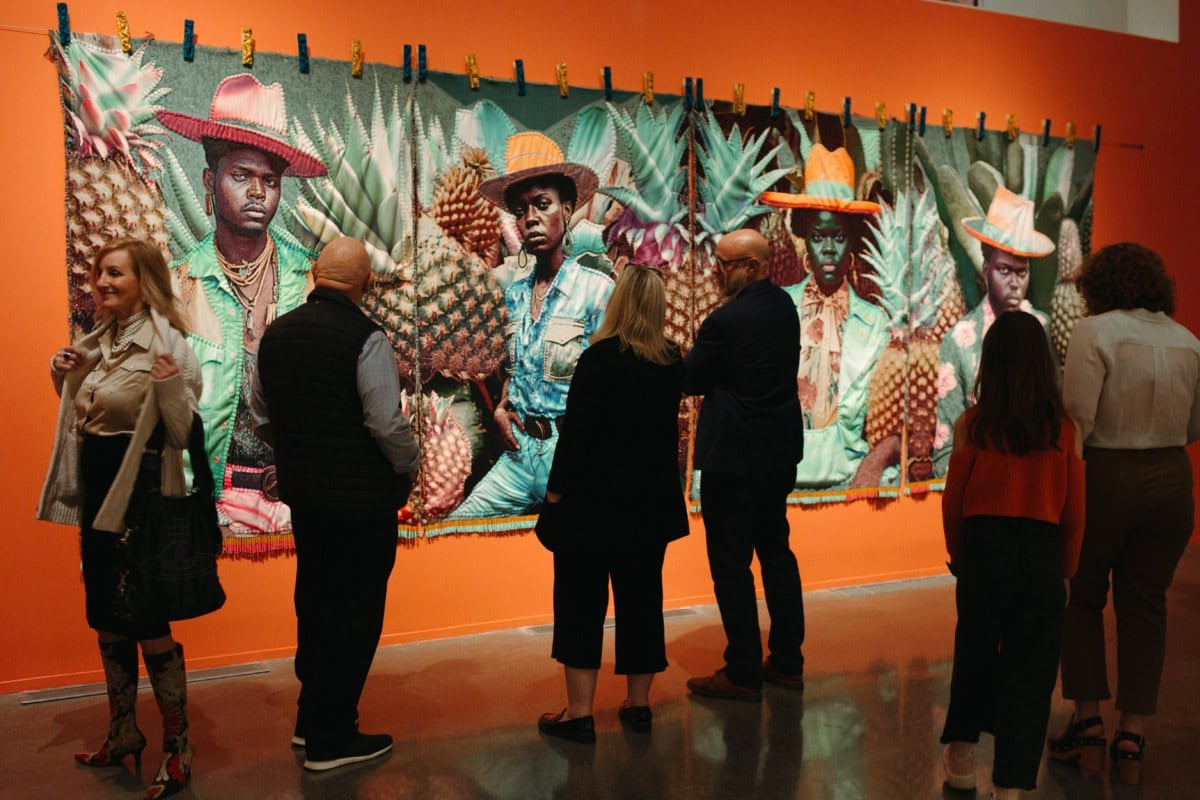
RG: Many of the artists tackle theoretical concerns and ideologies through traditional craft and mark-making methods, rendering somewhat abstract concepts tactile and tangible. For instance, Aliyah Bonnette says her quilts visualize the subject’s (and artist’s) path to finding their true self, “imagining who we may have been without the interference of colonization.” What do you hope to make tangible with this exhibition?
MB: Overall, the artwork throughout this exhibition contributes to an ongoing global discourse that acknowledges the malleability of identity and its many understandings. The texture and dimensionality of each fiber work convey fluidity in both a literal and conceptual sense. These artists’ depictions of people and concepts often exist outside the confines of societal assumptions, highlighting community-based countercultures that allow space for experimentation and reflection. In these ways, this exhibition for me feels liberating. I hope people leave the space with a similar sense of being limitless.
RG: Was it important to you that this exhibition brings together artists who are all at different stages in their careers and include North Carolina artists?
MB: That is an overarching goal of mine. I never want anyone’s “level” of experience or expertise to hinder them from an opportunity. If the work resonates with the exhibitions I’m trying to produce, I will always consider it. I also believe in uplifting North Carolina artists because that is the public I serve. I want folks here to see that our state has always influenced the art world. There’s a saying that “all roads lead through North Carolina,” and I truly believe that [Laughs]. It always amazes me how many people are connected to our state somehow, whether they were raised or had roots here.
Aliyah Bonnette, Ambrose Rhapsody Murray, Lakea Shepard, and Lien Truong were our North Carolina artists for this exhibition. Each of them deserves to be in dialogue with other leading global artists.
RG: I also wanted to discuss the interplay between the work and the space of SECCA itself. SECCA’s grounds were once the home of textile industrialist and civic leader James G. Hanes, and, before that, were the traditional territory of the Cheraw, Catawba, Occaneechi, Tutelo, and Keyauwee nations. It feels all too fitting to address concerns of the historic devaluation of textiles, of domestic labor, in the former home of a basic apparel kingpin.
MB: The history of the Hanes family, particularly their industrial endeavors that contributed to numerous disparities across our state, definitely influences my approach to curating this space. I am hyper-aware that the museum continuously honors and benefits from the family’s wealth, which they accumulated through land and labor exploitation that disproportionately affected communities across racial and economic boundaries.
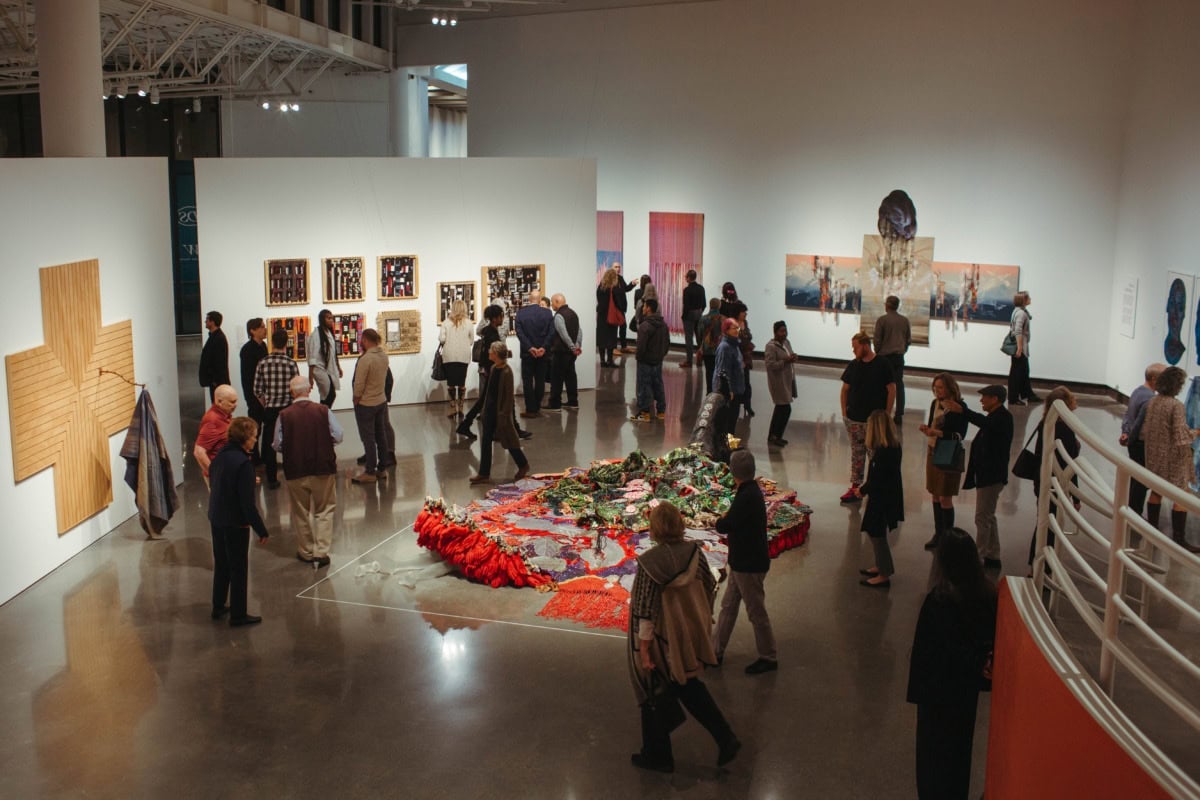
With that in mind, I wanted to reflect on other implications of textiles in the contemporary, specifically as communal tools of honor. For example, I thought about memorial quilts, like the NAMES Project AIDS Memorial Quilt, that celebrate communities despite attempts to stigmatize or completely erase their existence. These weavings exist as a record that exclaims people’s presence. I could literally go piece by piece in the exhibition and describe how each of them reflects these ideals. All the artists in the exhibition create works that carry a similar desire through record-keeping and homage that advocates for their inclusion in the intersecting legacies between the museum and the overall practice of fiber arts. They are saying, ‘We are here. Our stories matter.’
RG: The title emphasizes this communal aspect too; each piece mines different cultural, regional, or global histories and personal significance but also seems to be in direct conversation with other works in the show. What does the title signify for you?
MB: I name most of my exhibitions after poems or songs that either share similar themes or play on certain words. The Threads We Follow comes from a poem by William Stafford called, “The Way It Is.” In this poem, Stafford considers the idea of purpose and how we keep steady, especially as circumstances change around us. Instead of purpose, I was thinking of identity as the thread. I wanted a title that captured the artists’ relationships to identity throughout the exhibition. They’re translating their experiences to fiber in a way that either affirms or subverts Stafford’s perspective, depending on which piece you’re viewing. For many of these artists, identity expresses where you are currently in life. It can also allude to where you’ve been and where you’re going.
I want folks here to see that our state has always influenced the art world. There’s a saying that “all roads lead through North Carolina,” and I truly believe that.
RG: SECCA is an affiliate of the North Carolina Museum of Art in Raleigh, and you’re the Associate Curator of both museums. You’re also the first full-time Black curator in either institution’s over half-century history. How does it feel to bring such a significant and triumphant show centered around marginalized experiences into a traditionally white-centered space?
MB: Reflecting on my earlier answers – I try to be transparent about what working at an institution like ours says about my politics and advocacy work. All I want to do is cultivate a space that allows us to be. Whatever that means to us at the moment. As someone who recognizes the privileges they simultaneously have and don’t have, I am just thankful to be in this position.


